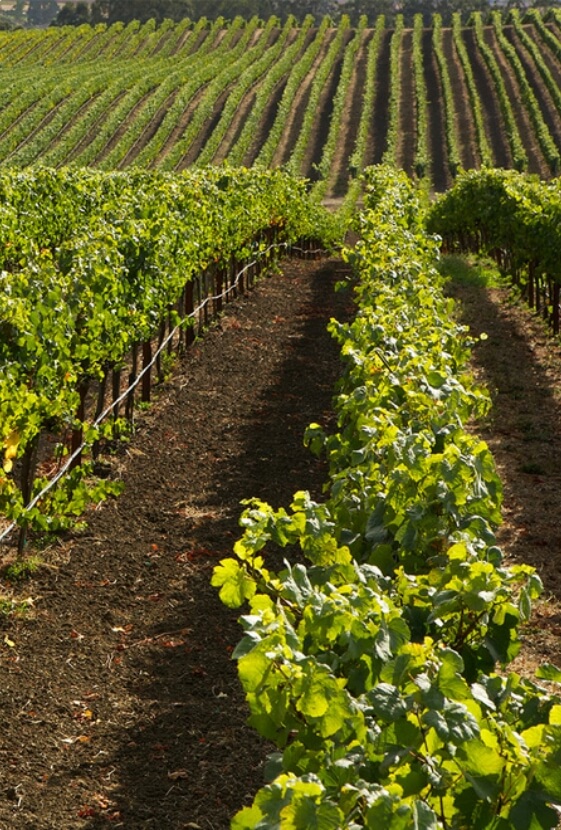In the Côte de Beaune, Chassagne-Montrachet, Meursault and Puligny-Montrachet are the three most famous white wine villages. Chassagne-Montrachet, reputed for its great Grands Crus, produces village whites that are the most robust in style. Meursault is often considered masculine in style compared to Puligny-Montrachet, which is charming, elegant and feminine. For red wine, Pommard is the most recognized village of the Côte de Beaune and often considered the most masculine red wine of the Côte. Other Louis Jadot village wines from the Côte de Beaune are:
Ladoix (white)
Pernand-Vergelesses (red and white)
Aloxe-Corton (red)
Chorey-lès-Beaune (red)
Savigny-lès-Beaune (red and white)
Beaune (red and white)
Pommard (red)
Volnay (red)
Auxey-Duresses (red and white)
Saint-Aubin (red and white)
Santenay (red and white)
Côte de Beaune Villages (white)
Archives: Vineyards
description
Sequoia Grove Estate Vineyard
Sequoia Grove’s Estate Vineyard lies in the Napa Valley’s most revered red wine growing region, midway between Rutherford and Oakville on the famous Rutherford bench, an area that extends east from the highway to the base of the Mayacamas mountains and is defined mainly by the distinct flavor characteristics it imparts in the Cabernet Sauvignon grown there. The Sequoia Grove Estate Vineyard’s 18 planted acres are dedicated primarily to Cabernet Sauvignon (85%), with the remainder to Cabernet Franc, Merlot, Petit Verdot and Malbec. Each variety and clonal selection has been matched with the soil type to which it is best suited, with Cabernet Sauvignon in gravelly loam and other varieties in the deeper, richer soils.
Tonella Estate Vineyard
In 2006, Sequoia Grove reached an agreement with the Tonella family to take control of their famed vineyard on the Rutherford bench. The 48 planted acre parcel lies on Skellenger Lane, close to the Oakville line. The vineyard has a long history; it was originally part of the Mexican land grants and was owned by the diocese of San Francisco for a time. Over the next 70 years, the property was owned by the Rutherford brothers (for which Rutherford is named) followed by the Ponti family, who eventually sold it to the Tonella family in the early 1900s.
Vineyard Manager Steve Allen, in close cooperation with Michael Trujillo and Molly Hill, replanted the vineyard to select Cabernet Sauvignon clones that would reach maturity and support the Sequoia Grove wines beginning with the 2010 vintage. With its variety of soil compositions and microclimates, Tonella Vineyard produces fruit with distinctive Rutherford character and flavor profiles.
Côte de Nuits Premiers Crus
Maison Louis Jadot produces 15 Premier Cru wines from the Côte de Nuits, 9 of them from wholly owned vineyards.
In Gevrey-Chambertin: Clos Saint Jacques, Estournelles Saint Jacques, Lavaux-Saint-Jacques, Petite Chapelle, Poissenots;
In Chambolle-Musigny: Les Amoureuses, Les Baudes, Les Charmes, Les Feusselottes, Les Fuées;
In Vosne-Romanée: Les Beaux Monts, Les Suchots, Malconsorts;
In Nuits-Saint-Georges: Damodes, Les Boudots.
Côte de Nuits Grands Crus
Of the 23 Grands Crus in the Côte de Nuits, Maison Louis Jadot produces wines from 14:
Mazis-Chambertin
Chambertin Clos de Bèze
Chambertin
Chapelle-Chambertin
Charmes-Chambertin
Latricières-Chambertin
Griotte-Chambertin
Clos de la Roche
Clos-Saint-Denis
Bonnes Mares
Musigny
Clos Vougeot
Echézeaux
Grands Echézeaux
Il Pareto Vineyard
At 350 meters in elevation, the 10-acre Il Pareto vineyard has clay soil with lime and gravel-size stones. The soil composition is ideal for Cabernet Sauvignon, with a high proportion of galestro rock.
Côte de Nuits Village Wines
Jadot’s village wines are grown on an extension of the slopes where the Premiers and Grands Crus are situated. Among the Côte de Nuits villages, Gevrey-Chambertin is the most renowned. Here, Pinot Noir has been refined to a pinnacle of expression. Nuits-Saint-Georges is the southernmost commune of the Côte de Nuits and produces some of its sturdiest and longest-lived wines. Other Louis Jadot village wines from the Côte de Nuits are:
Marsannay (red and white)
Fixin (white)
Chambolle-Musigny (red)
Vosne-Romanée (red)
Côte de Nuits Villages (red and white)
Côte de Beaune Grands Crus
Soil and aspect are crucial to Grand Cru vineyard siting, and soils vary widely in the Côte de Beaune. The Grand Cru white Montrachet is perfectly situated on a strip of east-facing limestone for an intense wine of great depth and aging potential. Surrounding Grands Crus include Chevalier-Montrachet, on stonier soil, and Bâtard-Montrachet, on heavier soil. At the northern border of the Côte de Beaune, the hill of Corton produces both a white and a red Grand Cru: the white on the upper south- and west-facing slopes on brown marl soil with limestone washed down from above; the powerful red is produced on a band below the white. Following are the Maison Louis Jadot Côte de Beaune Grands Crus:
Corton Charlemagne
Corton-Grèves (red)
Corton-Pougets (red)
Bâtard-Montrachet
Bienvenues-Bâtard-Montrachet
Criots-Bâtard-Montrachet
Chevalier-Montrachet
Chevalier-Montrachet Les Demoiselles
Montrachet
Cerequio
Michele Chiarlo owns the Antico Podere Averame in the Cerequio cru of Barolo, a 3-hectare vineyard planted in 1972. Soils are calcareous Sant’Agata marl with poor organic content but rich in microelements such as magnesium and manganese. South-southwest exposure promotes ripening and the vineyard elevation is 320 meters.
La Court
La Court is a single Barbera d’Asti vineyard of 6 hectares purchased in 1995 as part of the estate of Azienda Agricola Aluffi in Castelnuovo Calcea, considered to the most beautiful and prestigious property in the heart of the classic Barbera d’Asti zone. Planted in 1973, the vineyard has soils of calcareous marl poor in organic content but rich in magnesium, and a south-southwest exposure at 240 meters elevation.
